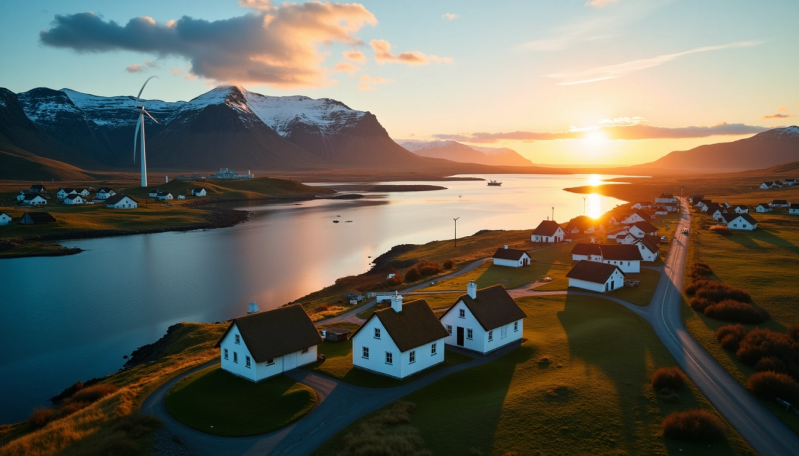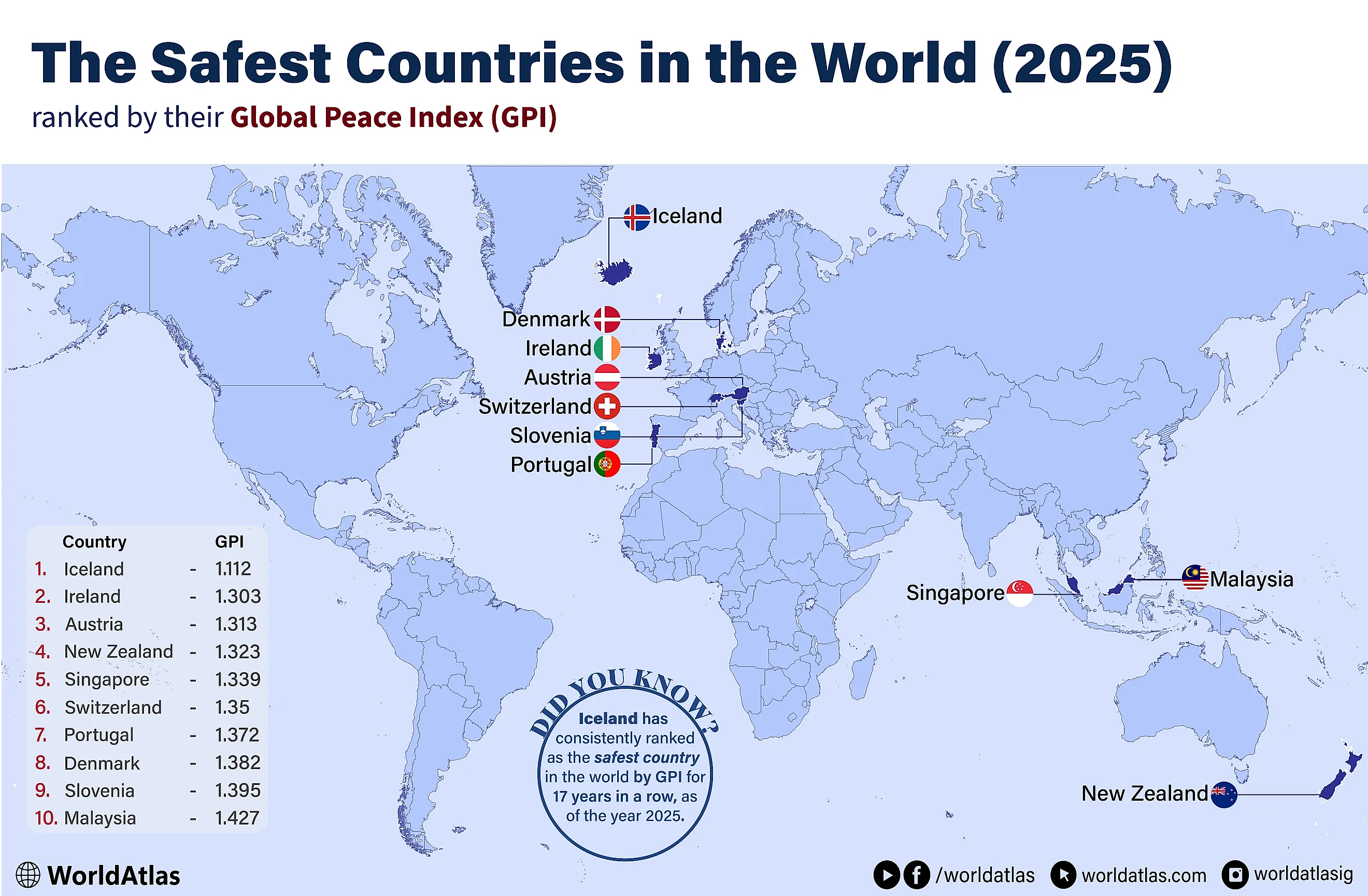
The search for the world's safest country in 2025 has become more crucial. Global conflicts have reached their highest levels since World War II. The Institute of Economics and Peace (IEP) ranks Iceland as the world's most peaceful country based on complete measurements.
Global conflict deaths hit a 25-year peak according to the 2025 Global Peace Index. This makes the rankings of peaceful countries more significant now. Several nations have improved their safety metrics despite concerning worldwide trends. Iceland showed remarkable progress with a 2% improvement this year. This progress helped Iceland pull ahead of other top-ranked nations. The sort of thing i love about these nations is how they stand out in the global peace index. This piece will get into the surprising changes in the world's safest country rankings for 2025.
How the Global Peace Index Measures Safety
Image Source: Reddit
The Global Peace Index (GPI) is the world's leading measure of global peacefulness. The Institute for Economics and Peace (IEP) has developed this index since 2007. Australian entrepreneur and philanthropist Steve Killelea created this detailed analysis that covers 163 countries. These countries represent 99.7% of the world's population.
The GPI's value comes from its systematic way of using 23 qualitative and quantitative indicators across three key domains. Ongoing Domestic and International Conflict, the first domain, looks at how countries are involved in internal and external conflicts. This domain accounts for 40% of a country's final score. Societal Safety and Security, the second domain, uses eleven indicators to measure a nation's harmony. These indicators track crime rates, terrorist activity, violent demonstrations, and refugee populations. The third domain, Militarisation, measures a country's military build-up through six indicators. These include military expenditure as a percentage of GDP and contributions to UN peacekeeping missions.
Experts weight each indicator after it is normalized on a scale of 1-5. The GPI builds on "Negative Peace"—the absence of violence or fear of violence—as its foundation. This systematic approach enables consistent yearly comparisons and reveals a growing gap between the most and least peaceful countries. The index also shows strong connections between peace, democracy, and lower corruption levels.
Top 5 Safest Countries in the World 2025

Image Source: World Atlas
The 2025 Global Peace Index shows Iceland still leads as the world's safest country. This marks their 17th straight year at the top with a score of 1.095. The country's safety comes from its high living standards, small population, and strong social values against crime. Citizens also trust their police force deeply.
Ireland stands second with 1.260. The country earned high marks because it reduced military spending and stayed away from conflicts. Their peaceful approach shows through their neutral military stance and how they prefer to solve problems through diplomacy.
New Zealand climbed two spots to reach third place, scoring 1.282. The island nation improved its safety measures and saw fewer terrorism-related issues. They follow Iceland's example with tough gun laws, and their police officers patrol without firearms.
Austria secured fourth place with 1.294. Since declaring neutrality in 1955, the country focused its resources on internal development instead of conflicts. This strategy helped build strong social systems where citizens trust each other more.
Switzerland rounds out the top five with a similar score of 1.294. The Swiss created a secure environment through their long-term neutral stance and stable politics, which drew many international organizations. Their political system works on steady policies and group decisions, which helped boost their safety rating.
Surprising Shifts in the 2025 Rankings
Image Source: Visual Capitalist
The 2025 peace rankings show major changes in the global peace map. Azerbaijan made remarkable progress in peacefulness and climbed 17 places to 95th. The country achieved a complete elimination of conflict deaths after the Nagorno-Karabakh ceasefire. Saudi Arabia moved up 14 places with improvements in every domain, thanks to better diplomatic relationships with Iran and Lebanon.
The rankings brought unexpected news from traditionally peaceful nations. Canada still ranks among the world's most peaceful countries but saw the fifth-largest drop globally. This decline stems from increased violent crime and worsening U.S. relations. Russia hit a historic low by ranking as the least peaceful country, with Ukraine following closely behind.
Peace declined globally for the sixth straight year, with 87 countries becoming less peaceful while 74 improved. North America saw the steepest regional decline. The Middle East and North Africa continue to be the world's least peaceful region.
Global power dynamics have changed significantly. The number of countries with "substantial influence" has grown from six in the 1970s to 34 today. Military spending continues to rise worldwide. Meanwhile, peacekeeping budgets have dropped to 0.52% of military expenditure - the lowest in more than 20 years.
Conclusion
Global conflicts have reached their highest levels since World War II, yet some nations still shine as examples of peace and safety. Iceland continues to lead the world's safety rankings for 17 straight years and has widened its lead over other peaceful nations with a 2% improvement this year. The bigger picture looks concerning though - 2025 marks the sixth straight year of declining global peace, where 87 countries became less peaceful while only 74 showed improvement.
Ranking changes paint a vivid picture of our evolving world. Azerbaijan's ceasefire agreements helped reshape the scene as the country jumped up 17 places. Some stable nations faced unexpected hurdles, as seen in Canada's situation. The country showed the fifth-largest drop globally because of rising crime rates and diplomatic tensions.
Russia has now earned the dubious title of least peaceful country, with Ukraine right behind. This change shows a deeper trend toward militarization worldwide. Defense spending keeps climbing while peacekeeping budgets have dropped to just 0.52% of military expenses - the lowest we've seen in over 20 years.
Power dynamics have altered the map of global safety. Currently, 34 countries have "substantial influence" over others, up from just six in the 1970s. These rankings work as both a warning sign and a guide. While conflict deaths hit a 25-year peak, successful examples like Iceland, Ireland, and New Zealand show how nations can build safety. Their formula includes strong social attitudes against crime, diplomatic conflict resolution, and domestic investment rather than military spending.
FAQs
Q1. What are the top 5 safest countries in the world for 2025? According to the Global Peace Index, the top 5 safest countries in 2025 are Iceland, Ireland, New Zealand, Austria, and Switzerland. Iceland maintains its position as the safest country for the 17th consecutive year.
Q2. How is the Global Peace Index calculated? The Global Peace Index uses 23 qualitative and quantitative indicators across three domains: Ongoing Domestic and International Conflict, Societal Safety and Security, and Militarisation. Each indicator is normalized on a scale of 1-5 and weighted according to expert judgment.
Q3. Which country showed the most significant improvement in peace rankings? Azerbaijan recorded the largest improvement in peacefulness, jumping 17 places to 95th in the rankings. This improvement was primarily due to a 100% reduction in conflict deaths following the Nagorno-Karabakh ceasefire.
Q4. Has global peace improved or declined in recent years? Global peace has been declining, with 2025 marking the sixth consecutive year of decline. In the latest rankings, 87 countries deteriorated in peacefulness while only 74 improved.
Q5. How has military spending affected global peace? Military expenditure is increasing worldwide, while peacekeeping funding has fallen to just 0.52% of military spending, the lowest level in over two decades. This trend contributes to the overall decline in global peace.
Add comment
Comments